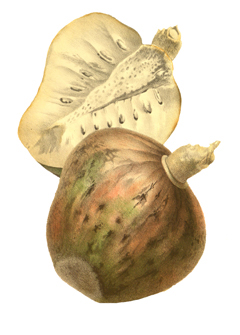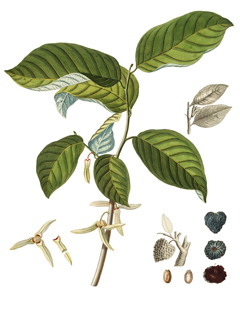 |
|
https://edibleplants.org/ |
 |
| https://edibleplants.org/ |
Translate this page:
Summary
Cherimoya or Custard Apple (Annona cherimola) is a small deciduous tree that grows up to 6 - 10 m tall. The fruit is cone or heart shaped, has juicy flesh, and can weigh up to 0.5 kg each. The seed is powdered and used medicinally. It is then mixed with grease as treatment for parasitic skin disorders. Decoction of the fruit?s skin is used to relieve pneumonia. The fruit can be eaten raw. It tastes like banana and pineapple. The flesh is white in color, sweet, juicy, and fragrant. The fruit is used for making ice cream, custard, and cakes. The crushed seed is used as an insecticide. Other Names: Anona, Chirimoya, Chermoya, Hanuman phala, Noina ostrelia, Sherbet-fruit.
Physical Characteristics

 Annona cherimola is a deciduous Tree growing to 9 m (29ft) by 9 m (29ft) at a fast rate.
Annona cherimola is a deciduous Tree growing to 9 m (29ft) by 9 m (29ft) at a fast rate.
See above for USDA hardiness. It is hardy to UK zone 9 and is not frost tender. The plant is self-fertile.
It is noted for attracting wildlife.
Suitable for: light (sandy), medium (loamy) and heavy (clay) soils, prefers well-drained soil and can grow in heavy clay and nutritionally poor soils. Suitable pH: mildly acid, neutral and basic (mildly alkaline) soils and can grow in very alkaline soils.
It cannot grow in the shade. It prefers dry or moist soil and can tolerate drought.
UK Hardiness Map
US Hardiness Map
Synonyms
Plant Habitats
Edible Uses
Edible Parts: Fruit
Edible Uses:
Fruit - raw. A delicious flavour, tasting like a cross between a banana and a pineapple[ 301 ]. The white flesh of the ripe cherimoya is sweet, juicy and very fragrant. It is most commonly eaten out of-hand or scooped with a spoon from the cut open fruit[ 303 ]. It can also be used in making ice cream, custard, cakes etc[ 301 ]. The fruit is up to 20cm x 10cm and has a white pulp[ 200 ].
References More on Edible Uses
Medicinal Uses
Plants For A Future can not take any responsibility for any adverse effects from the use of plants. Always seek advice from a professional before using a plant medicinally.
Rural people toast, peel and pulverize 1 or 2 seeds and take the powder with water or milk as a potent emetic and cathartic. Mixed with grease, the powder is applied on parasitic skin disorders[ 303 ]. A decoction of the skin of the fruit is taken to relieve pneumonia[ 303 ].
References More on Medicinal Uses
The Bookshop: Edible Plant Books
Our Latest books on Perennial Plants For Food Forests and Permaculture Gardens in paperback or digital formats.

Edible Tropical Plants
Food Forest Plants for Hotter Conditions: 250+ Plants For Tropical Food Forests & Permaculture Gardens.
More

Edible Temperate Plants
Plants for Your Food Forest: 500 Plants for Temperate Food Forests & Permaculture Gardens.
More

More Books
PFAF have eight books available in paperback and digital formats. Browse the shop for more information.
Shop Now
Other Uses
Insecticide
Other uses rating: Low (3/5). Cherimoya can be used in agroforestry systems as a fruit tree. It provides shade and can be integrated into diverse cropping systems. The seeds are crushed and used as insecticides [ 303 ]. Mixed with grease, powdered seeds are used to kill lice[ 303 ]. 1. Nectary - Flowers rich in nectar and pollen:
Yes – Many Annona species (such as cherimoya, soursop, and sugar apple) have flowers that attract pollinators, particularly beetles, because of their pollen.
2. Wildlife - Food (Fruit, Seeds, Leaf litter, Shelter, Nesting, Roosting):
Yes, the fruits of the Annona species are edible and can feed wildlife, while their foliage may provide shelter and nesting spots for birds and other small animals.
3. Invertebrate Shelter (Overwintering sites, Leaf litter, Groundcover):
Yes – The leaf litter from Annona trees can provide shelter for invertebrates, and their bark may offer overwintering sites for certain insects.
4. Pest Confuser (Smell):
No – Annona species do not produce strong, aromatic smells known to confuse or repel pests.
Special Uses
Food Forest
References More on Other Uses
Cultivation details
The cherimoya does not grow very well in lowland tropical areas, preferring elevations above 700 metres and growing well as high as 2,400 metres[ 303 ]. It can also be grown in subtropical and warm temperate basically frost-free areas. Prefers a moist, sandy loam with a pH around 6[ 200 ]. It grows well on a wide range of soil types from light to heavy, but seems to do best on a medium soil of moderate fertility[ 303 ]. It prefers a pH in the range 6.5 - 7.6[ 303 ]. The tree requires protection from strong winds that interfere with pollination and fruit set[ 303 ]. This species has often escaped from cultivation and has become widely naturalized in subtropical to tropical climates[ 200 ]. The cherimoya begins to bear when 3_ - 5 years old and production steadily increases from the 5th to the 10th year, when there should be a yield of 25 fruits/tree (5,000 per ha)[ 303 ]. In Colombia, the average yield is 25 fruits and in Italy, trees 30-35 years old produce 230-280 fruits annually[ 303 ]. A problem with the cherimoya is inadequate natural pollination because the male and female structures of each flower do not mature simultaneously. Few insects visit the flowers. Therefore, hand-pollination is highly desirable and must be done in a 6 - 8 hour period when the stigmas are white and sticky. It has been found in Chile that in the first flowers to open the pollen grains are loaded with starch, whereas flowers that open later have more abundant pollen, no starch grains, and the pollen germinates readily. Partly-opened flowers are collected in the afternoons and kept in a paper bag overnight. The next morning the shed pollen is put, together with moist paper, in a vial and transferred by brush to the receptive stigmas. Usually only a few of the flowers on a tree are pollinated each time, the operation being repeated every 4-5 days in order to extend the season of ripening. The closely related A. Senegalensis, if available, is a good source of abundant pollen for pollinating the cherimoya, that of the sugar apple is not satisfactory. Fruits from hand-pollinated flowers are normally superior in form and size[ 303 ]. When is it harvested?
Late Autumn to Early Winter.
When does it flower?
Late Spring to Early Summer.
Are there any agroforestry uses?
How fast does it grow?
Cherimoya has a moderate growth rate and can take about 3 to 4 years to start producing fruit after planting.
References Carbon Farming Information and Carbon Sequestration Information
Temperature Converter
Type a value in the Celsius field to convert the value to Fahrenheit:
Fahrenheit:
The PFAF Bookshop
Plants For A Future have a number of books available in paperback and digital form. Book titles include Edible Plants, Edible Perennials, Edible Trees,Edible Shrubs, Woodland Gardening, and Temperate Food Forest Plants. Our new book is Food Forest Plants For Hotter Conditions (Tropical and Sub-Tropical).
Shop Now
Plant Propagation
Seed - usually breeds true to type[ 200 ]. Sow in individual pots, not deeper than 2cm, at 21c[ 200 ]. Cherimoya seeds remain viable for 2 - 3 years if kept dry and protected from weevils and fungi. At 20C bottom heat, seeds germinate in about 21 days, but require about 40 days under normal ambient growing conditions[ 303 ]. The seed of many species in this genus has a hard seedcoat and may benefit from scarification before sowing in order to speed up germination. This can usually be done by pouring a small amount of nearly boiling water on the seeds (being careful not to cook them!) and then soaking them for 12 - 24 hours in warm water. By this time they should have imbibed moisture and swollen - if they have not, then carefully make a nick in the seedcoat (being careful not to damage the embryo) and soak for a further 12 hours before sowing[ K ]. Semi-ripe cuttings[ 200 ]. Cuttings of mature wood have rooted in coral sand with bottom heat in 28 days[ 303 ].
Other Names
If available other names are mentioned here
Anona, Chirimoya, Chermoya, Hanuman phala, Noina ostrelia, Sherbet-fruit.
Native Range
SOUTHERN AMERICA: Bolivia, Colombia, Ecuador, Peru,
Weed Potential
Right plant wrong place. We are currently updating this section.
Please note that a plant may be invasive in one area but may not in your area so it's worth checking.
Possibly invasive in Easter Island, the Galapagos, Hawaii, and New Zealand.
Conservation Status
IUCN Red List of Threatened Plants Status : This taxon has not yet been assessed.

Growth: S = slow M = medium F = fast. Soil: L = light (sandy) M = medium H = heavy (clay). pH: A = acid N = neutral B = basic (alkaline). Shade: F = full shade S = semi-shade N = no shade. Moisture: D = dry M = Moist We = wet Wa = water.
Now available:
Food Forest Plants for Mediterranean Conditions
350+ Perennial Plants For Mediterranean and Drier Food Forests and Permaculture Gardens.
[Paperback and eBook]
This is the third in Plants For A Future's series of plant guides for food forests tailored to
specific climate zones. Following volumes on temperate and tropical ecosystems, this book focuses
on species suited to Mediterranean conditions—regions with hot, dry summers and cool, wet winters,
often facing the added challenge of climate change.
Read More
Expert comment
Author
Mill.
Botanical References
Links / References
For a list of references used on this page please go here
A special thanks to Ken Fern for some of the information used on this page.
Readers comment
| Add a comment |
|
If you have important information about this plant that may help other users please add a comment or link below. Only comments or links that are felt to be directly relevant to a plant will be included. If you think a comment/link or information contained on this page is inaccurate or misleading we would welcome your feedback at [email protected]. If you have questions about a plant please use the Forum on this website as we do not have the resources to answer questions ourselves.
* Please note: the comments by website users are not necessarily those held by PFAF and may give misleading or inaccurate information.
To leave a comment please Register or login here All comments need to be approved so will not appear immediately.
|
Subject : Annona cherimola
|
|
|
|